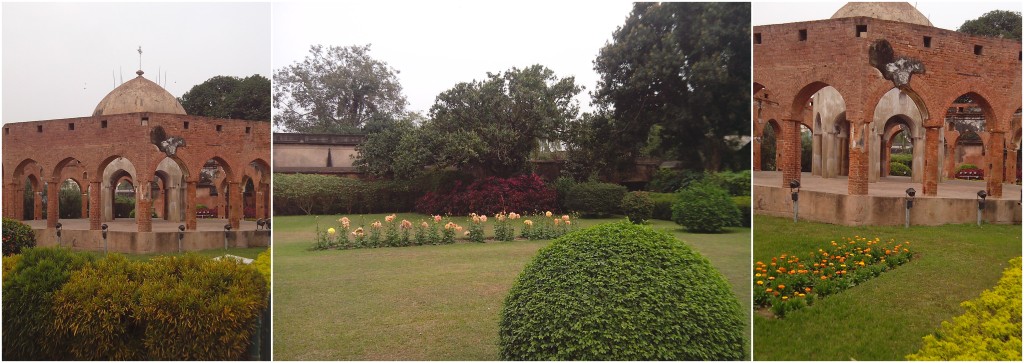Just next to Nava Kailash is the Rajbari Complex. The Rajbari premises is the star attraction of the Ambika Kalna and is very well maintained, along with the basic necessities like toilets. The temples are illuminated beautifully with colourful lights in the night, which is a remarkable scene to watch.
The Rajbari complex temples have been built at different periods by Kings of Burdwan and their family members. Due to Bargi attack, family premises and temples at Dainhat got destroyed, Burdwan kings chose this town for building a Thakurbari or Rajbari complex. Similiar Thakurbari called Raghunathbariwas constructed at Chandrakona town of West Medinipur.
Inside the Rajbari complex, the visitor first encounters the Odishi Deul structured Pratapeshwar temple. This temple was built in 1849 by Ramhari Mistri under the supervision of Pearykumari Devi, first wife of Raja Pratapchand (son of King Tejchandra). Pratapeshwar temple has unparallel terracotta works on its four walls. Check out for plaques with the battle of Ram and Ravana with Goddess Durga as Mahishashurmardini in the centre, Rama as king of Ayodhya with Sita seating beside him, and a huge horizontal panel showing the various forms of Krishnalila. There are terracotta plaques on all the outer walls of the temple as well as in its inner sanctum. Various social scenarios as well as scenes from Krishnalila can be observed here. There are Terracotta decorated false doors on three sides of the temple.

From Pratapeshwar temple walking straight, you might bypasses a Rasmancha on the left side. This structure has one dome shaped pinnacle with two sections. The outer section has 24 gateways whilst the inner has 8 gateways. The roof has been completely demolished with the vagaries of time. In the era of Burdwan kings, during Ras festival, the deities Laljiu and Madan Gopal Jiu used to be enacted here amidst great pomp and show. The structure of this Rasmancha is as unique as that of Bishnupur.

From the Rasmancha you might head towards an enclosure with a gate surrounded by high walls. This enclosure houses the Laljiu Temple and the Giri Gobardhan Temple, the entrance of the enclosure, has three horse statues seen hanging from top. A horse was the mascot of the Burdwan Raj family. Out of the five Panchabingshati (25 pinnacled) temples existing in West Bengal, Ambika Kalna boasts of three such temples. Laljiu temple is the oldest of these 25 pinnacled temples. The pinnacles are distributed in 12+8+4+1 style. On the first floor roof, there are 12 pinnacles. On the octagonal second floor there are 8 pinnacles and the top there are four pinnacles with the final giant pinnacle in the centre.

Built in 1739 by Raja Kirtichand Rai of Burdwan for his mother Brajakishori Devi, Laljiu temple has a huge multi open entrance Naatmandir alias assembly hall of Chaarchala( Four sloped roofs) style standing on several pillars in its front. The structure is unique and one of its kind. Interesting terracotta panels can be seen on its walls. Once it had several Terracotta work on its walls and its triple entrance Jagamohan (Porch) which has been reduced to a handful at present. Besides usual Krishnalila scenarios, hunting scenes of Europeans on horseback and British soldiers with guns which reflects social scenarios of that period, can be observed here. Near the roof of Laljiu temple, one can see an exquisite stucco work showing an elephant with floral designs. On the corners of the temple, there is well-known “death creeper” (Mrittulata) styled plaque which usually adorned corners of architectures in a vertical fashion. The figures of soldiers leaning on each other can be seen during hunting session in a repetitive manner.
The deity of temple is Radha and Krishna. It is said that the idol of Krishna was obtained from a poor Sadhu (known as Lalaji) by Brajakishori Devi. The Sadhu was initially reluctant to part with his idol, but the king’s mother proposed a marriage of Krishna with her Radha idol. Lalaji stayed back at Ambika Kalna to worship his idol and died here. It is said that the name of the Laljiu temple has been coined by his name.
In the same enclosure opposite to Laljiu is the 1758 built Giri Gobardhan temple. The roof is designed like a mountain with several figures of human and animals. This is a rather late style in Bengal school of temples. Thus it can be very well concluded that Kalna houses all different forms of architecture found in Kalna along with all different forms of temples prevalent in bangle, a must visit.

